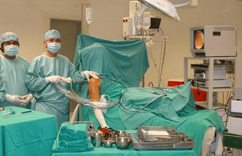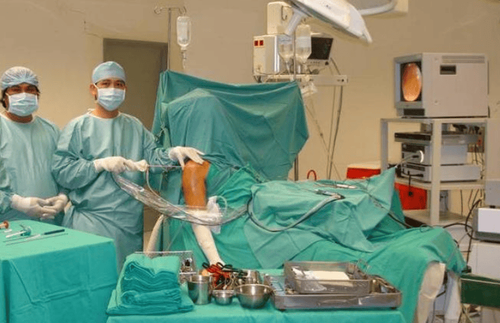A patient with a risky type A aortic dissection was successfully operated on by doctors from Vinmec International General Hospital's cardiology department. Doctors performed emergency surgery on the patient overnight, and two units of artificial platelets were transfused. This patient is one of the rare type A aortic dissection patients who has been spared in time thus far and the first with the condition to be diagnosed at Vinmec Hospital.
Suddenly ripping chest agony
Few people can realize that Mr. Hoang Ngoc T (50 years old, Hanoi) had overcome a difficult surgery to survive less than a month ago based on his muscular physique, firm walk, and kind voice. On the morning of his daughter's wedding, Mr. T. recalled that he woke up early and heard a "pop" sound in his chest more than three weeks prior. He soon experienced chest pain, lightheadedness, and stumbling. Or the stent that was implanted in the chest has become dislodged, I thought at once (Mr. T. had a coronary stent placed 1 year ago because of acute coronary syndrome).
He attempted to sit in a chair, but his chest hurt so bad and he was perspiring so heavily that it seemed like someone had dumped water on him. He tried to climb the stairs and enter the room to summon his wife, but no one was there because it was still early in the morning. Family members of Mr. T. brought him to Vinmec International General Hospital's emergency room. Here, he was checked by medical professionals who used coronary angiography and computed tomography to diagnose type A aortic dissection, which required immediate surgery to have a chance of survival.
Hoang Ngoc T. underwent surgery for a type A aortic dissection.
An immediate cardiac emergency
Aortic dissection, commonly known as aortic dissection, is a true tragedy, according to MSc. BS. Nguyen Hoang Ha, acting head of the cardiology department at Vinmec Hospital and the surgeon who immediately operated on T. With type A dissection, around 50% of patients pass away within the first 48 hours, and those who survive have very little chance of doing so without surgery. Hypertension, aortic disease, and old age are risk factors for the condition to manifest.
The aorta's structure consists of three layers (peritoneum, mediastinum, and endothelium). The blood in the artery overflows into the dissected region of the endothelium more and more as a result of some condition (hypertension, middle coat illness, connective tissue disease, etc.) that causes the dissection. The dissected area is bloated and on the verge of bursting. Patient has right and left asymmetry in blood pressure and pulse, as well as acute, intense chest pain. Type A aortic dissection is connected to the position of the ascending aorta; type B aortic dissection is unrelated. If treated late, type A is nearly certainly fatal (also type type). A majority of the time, medical treatment does not necessitate surgery.
Aortic rupture into the pericardium, acute myocardial infarction from a blocked coronary artery, sudden heart failure from an aortic valve regurgitation, or stroke from a blocked cerebral artery are all causes of death. Therefore, it is crucial to do surgery as soon as possible in cases of type A aortic dissection. The patient's probability of dying rises by 1% for every extra hour of waiting.
Challenging before an operation that is difficult to stop bleeding
According to MSc. Nguyen Hoang Ha, it is difficult to plan an emergency operation for patients with type A aortic dissection since the aorta must be used because it is the artery that supplies blood to the entire body. employ an artificial heart and lung machine, however there are times when it needs to be stopped (stopping the entire body's circulatory system) by reducing the temperature to the lowest level to protect the internal organs when doing aortic replacement. shattered apart. The most terrifying effect of this is the ease with which coagulation disorders (patients with uncontrollable bleeding) can be caused, particularly in T patients who are taking an attack dose of antiplatelet medication. When the body temperature is dropped, there is a risk of serious bleeding that cannot be stopped (due to coronary stent insertion one year ago). However, if surgery is delayed, the patient will also pass away. And the medical professionals decided that, despite the considerable danger, there was still a possibility to rescue the patient.
Three weeks after surgery, patient Hoang Ngoc T. (center) is shown joking around with doctor Nguyen Hoang Ha (left). (Image by Tuan Anh)
12 swabs of gauze were kept in the chest
To safeguard the brain, marrow, kidneys, and other organs in the body, the surgical team, led by MSc. BS. Nguyen Hoang Ha, made a big incision along the sternum, operated an artificial heart and lung machine, and reduced the body temperature from 25 to 18 degrees. Complete circulatory arrest is followed by only some brain perfusion. Remove the dissection in the ascending aorta before continuing with the replacement. Restart the cardiopulmonary apparatus, increase body temperature, halt bleeding, and get ready to finish the procedure. The patient was bleeding extensively at this point and could not be stopped by using standard hemostatic techniques, which made Dr.Ha nervous. The patient had to be sent to resuscitation after BS. Ha used 12 gauze pads to wrap snugly around the replacement aorta and temporarily seal the thorax. After 36 hours, the patient was no longer bleeding thanks to the combination of the hemostatic medication's impact and the pressure of the gauze. The chest was now formally closed by the doctors after removing all of the gauze. The patient was released ten days following the procedure.
This is one of the few cases of type A aortic dissection that was swiftly saved and the first type A aortic dissection (with very significant risks in surgery) that was successfully operated on at Vinmec Hospital. Opening a trustworthy address thus far for people with risky cardiovascular conditions.
Please dial HOTLINE for more information or register for an appointment HERE. Download MyVinmec app to make appointments faster and to manage your bookings easily.













